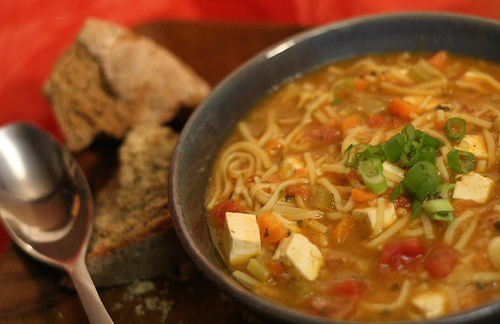
Lovin’ Fresh is a series of recipes
designed to showcase produce gathered
from local farms or grown in my own garden.
I know that my timing might seem a little off for writing a post about soup in April when most folks are soup-happy in November. But the way I see it, there are still plenty of reasons to talk about soup right now. For starters, spring colds are common, at least at my house. There are still some root vegetables languishing away, desperate to be used up before the onslaught of spring veggies. However, that onslaught hasn’t come just yet so there’s all the more reason to use up the winter stores. And finally, as the garden gets churning away again in the new season, it’s good to have soup at the back of your mind; I find it’s a good way to use up the bounty to freeze for winter.
So, all that being said, let’s talk about the basic principles behind soup making. I’ll be so bold as to call this a “blueprint” and promise you that you’ll be able to make just about any soup your little heart desires without so much as a recipe clipping or blog post print-out (excpet this one, of course; you’ll need this one).






The Blueprint
1. Heat your fat (oil or butter or lard) in a large soup pot
2. Sauté any combination of garlic and onions
3. Add pinches of salt and pepper with each addition of ingredients in order to build your flavor
4. Add any combination of vegetables and continue sautéing
5. Add your dried herbs and spices and continue sautéing
6. Add your stock, at least enough to let the vegetables swim freely
7. Bring to a boil
8. If you want any pastas or grains, add them now.
9. Reduce to a simmer and cook until everything’s soft and happy – usually about 30 minutes
10. Add fresh herbs during the last ten minutes of cooking
11. Blend if you want a smooth soup and/or add cream if you want
12. Taste and season with more salt and pepper
13. Taste again!
14. If you wanted meat in there somewhere, depending on if it’s cooked or raw, add it in either step two (to brown beef), six (to cook chicken), or ten (for cooked anything)
With this blueprint in hand, you can make up a soup just like I did in the recipe below. It’s something I totally made up as I went along, scouring the cupboards for whatever seemed fair game in the soup making business.
Now tell me, what are some of the concoctions you think you’ll try, or have you already made up any soups on your own that you find particularly outstanding?

Herbed Tofu and Vegetable Soup
2 T. extra virgin olive oil
2 cloves garlic, minced
2 small onions, chopped
1 c. chopped carrots
1 celery stalk, chopped
1/2 c. diced tomatoes (I used canned)
2 t. dried marjoram
1 t. dried oregano
1 T. frozen basil puree or 2 T. fresh chopped
4 c. vegetable stock
1 c. small noodles or other pasta
1 sprig of fresh rosemary, finely minced
1 package of extra firm tofu, drained and diced
1 large scallion, sliced thin
salt and freshly ground black pepper
Heat the oil in a large heavy sauce or soup pot over medium heat. Add the garlic and onion. Stir and add a pinch of salt. Keep an eye on the onion and garlic while you chop the carrots and celery; when onion is translucent and garlic is browned, add the carrot and celery. Stir and add a pinch of pepper this time. Saute vegetables for about four minutes until they are beginning to soften. Add the diced tomatoes, oregano, marjoram and basil (if using frozen, otherwise save any fresh herbs for later in the process), stir and cook for another minute or two. Add another pinch of salt and pepper.
Add vegetable stock, raise heat and bring soup to a boil. Add pasta and turn down heat to medium again. After pasta begins to soften up (about 2 minutes), add the tofu, white parts of the scallion, and rosemary (if using fresh basil, add now too). Allow soup to simmer for about 10 minutes so the flavors meld. Taste and season with more salt and pepper as needed. Serve garnished with the green slices of scallion.
(serves 3-4)

